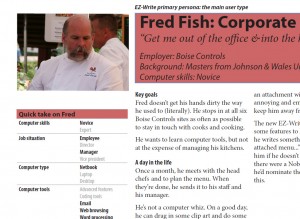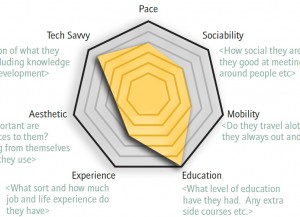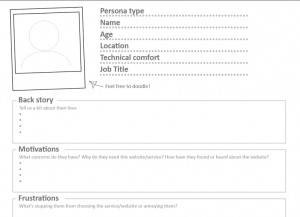
When dealing with web strategy in higher education - be it for marketing, content, or UI/UX - personas can and should play an important role in your process. Earlier this yearAssociate Director covered some of the introductory concepts behind what they are used for. Today I wanted to walk you through some additional information as well as provide you some resources for building your own.
Why Personas?
A persona is a “…fictional character created to represent the different user types within a targeted demographic, attitude and/or behavior set that might use a site, brand or product in a similar way” (more from Wikipedia). The idea is that it allows you to build a reference point when thinking about approaching issues related to content, usability, and other challenges we face. Think of it like WWJD. When sitting in a brainstorming session, or trying to anticipate a behavior, you should ask what your persona would do in a given scenario. In this way, the persona serves as a focusing lens for what would otherwise be random traits and ideas. By combining these and giving them a name, you empower that segment of users in your thought process.
This is especially important for higher ed, where we serve many different audiences with many different kinds of goals. We frequently talk about these groups, but rarely do we empower them by building faux users to refer to in addressing their needs. Consider the power of personas as a training and educational tool. Many of us work in environments where dozens of people contribute content to our site, people that may not be ideally suited for the creation of web content. By providing these users with reference personas, you can help direct their writing to appropriately address user needs. You can also use the personas in meetings to provide context for why a certain tool may function a certain way, or why wording on a particular call to action was developed the way it was.
Additionallypersonas can be used as a tool to bridge gaps between groups like marketing and IT. Both areas have a need for personas, and by getting them to use the same ones, you can get them working together more and using the same reference point when building, crafting, and developing. This is important since if one group uses a persona and one doesn’t, or both use them but use different ones, messages and meaning can become mixed up or confused. Any tool that can keep separate groups on the same page for strategizing is a powerful tool.
Types of Personas
In higher ed, we should consider at least one persona for each of our primary audiences. This can take a little time to flesh out, but can be very valuable in the long run. Additionally, rather than trying to build a persona for a group you aren’t particularly familiar with (i.e. top level donors), you can work with the groups responsible for those interactions to help build or verify the accuracy of your persona. For instance, let your alumni relations office help you build out a persona to represent someone from your alumni base (note the opportunity to use persona building to bridge a gap here).
Consider the following for building personas:
- High school age prospective student
- Recently graduated prospective graduate student
- Mother or father (don’t do “parents,” separate them. Men and women will approach tasks differently)
- Non-traditional prospective undergraduate student
- Employed prospective graduate student
- Prospective international student (undergrad or graduate)
- Faculty or staff members
- Alumnus
- Traditional, low level donor
- High value, C-level donor
- Current student (undergrad or graduate)
- Sports fan
- Research professionals
- Disabled user
These are just a handful of ideas. Obviously you’ll need to take into account any specialty audiences you serve, and lean on your analytics to help inform who should be targeted. Personally, I’d recommend not being afraid to get a little creative, as users aren’t always going to be average. Also, remember, users are people. So should your personas be. Don’t create a “persona” to represent a whole group of people. Similarly, don’t use them to represent a brand or a company. It’s fine to represent a person at a given company, but you need to respect the unique ways a particular individual will interact with your site.
Parts of a Persona
How far you take the development of a persona is really up to you. The more thought that goes into them, the better you can answer questions about what they would do or how they would behave in a given scenario, That aside, you should plan for at least a few common elements:
- Name: Obvious, right? Try to come up with something original. Don’t name it after someone in your office, and don’t name it after someone famous. Reason being, you don’t want to associate this with someone else. They should be unique.
- Picture: It’s important to put a face to your persona. Remember, your persona should elicit the feeling of a real human. Giving them a face helps with that.
- Age: In our case, age can be one of the important identifiers to which audience(s) they are part of.
- Qualities/Traits: Things like technical proficiency, hometown, job background, education level, and gear can all be important indicators for how the persona would react.
- Goals: What kinds of things will this user be coming to your site to do? Augment with information from interviews of real people as much as possible, don’t make guesses about what you think or what you want that kind of person to do.
- Questions: Sort of a supplement to the goals, these should be things the user would ask while looking at your site. Consider the language the user would use when asking the question as well, as it should reflect their attitude and personality.
- Quote(s): Put in a quote or two to help define the personality of the user you’re profiling.
Beyond that, you can include any number of additional things, like back stories, likes/dislikes, motivating factors, special needs, etc. Consider any special requirements you have when developing your site, and include persona details relevant to helping with those processes.
Resources
There are a lot of different ways to approach going about building a persona. If you need an idea of where to start, here are a few templates you can use for reference. Each of these takes a slightly different approach to what is important, and you should consider mixing and matching elements where it’s relevant. For instance, some use “skill sliders” to indicate experience level in certain areas kind of like a video game character customizer while others focus more on telling a story around the persona.
- Persona Template at Linowski Interaction Design
- Suze Ingram has two: Microsoft Word version or one based on Adaptive Path’s
- Zakiwarfel’s templates (available as PDF or for Adobe CS3/4)
- PDF template from Interaction Design
- Example templates from Research In Motion
- Joanne Richardson’s quick or detailed templates
- Example from Robert Barlow-Busch’s chapter in User Centered Design Stories
- Usability.gov example personas
- A whole mountain of examples and additional reading from the Society for Technical Communication
- Example personas along with some extra info at the Fluid Project
If you’d like additional reading on the subject of building, using, and maintaining personas, look up the books and The Persona Lifecycle: Keeping People in Mind Throughout Product Design. Remember, make persona creation a team activity, don’t try to do it on your own. This will help ensure that they are unique and reflect many different values, not just your own. If you keep the same persona year to year, make sure it grows over time and changes like a real person would. Don’t be afraid to get rid of or create new personas as it makes sense. And finally, put the personas into real use. Walk them through processes and apply them in scenarios. They can be a powerful tool in the quest for usability, but only if you take the time to properly build, construct, maintain, and apply them.
Photo credit: ![]() Some rights reserved by pj_vanf
Some rights reserved by pj_vanf



By Director of Web Marketing
Content StrategyGeneralMarketing